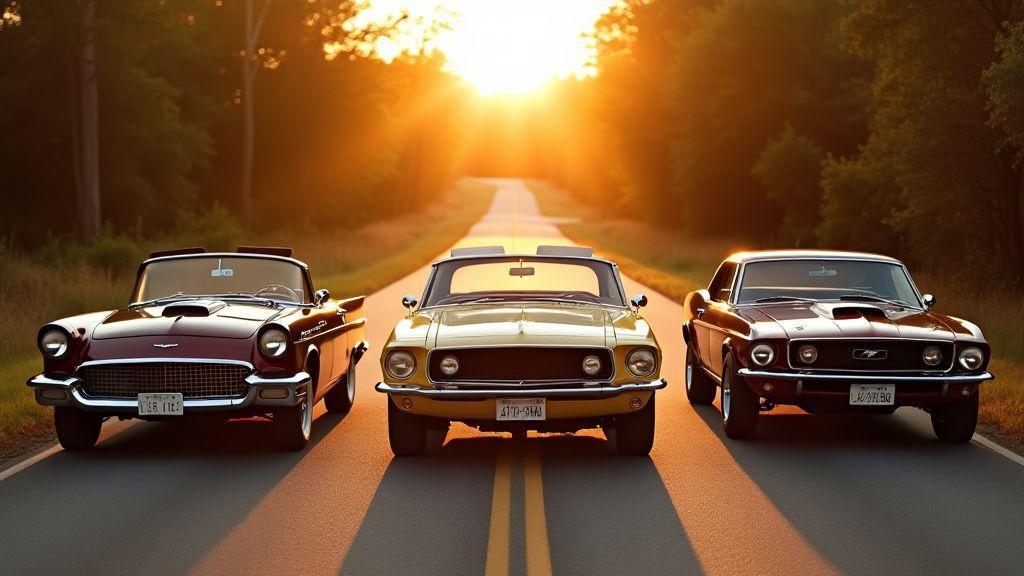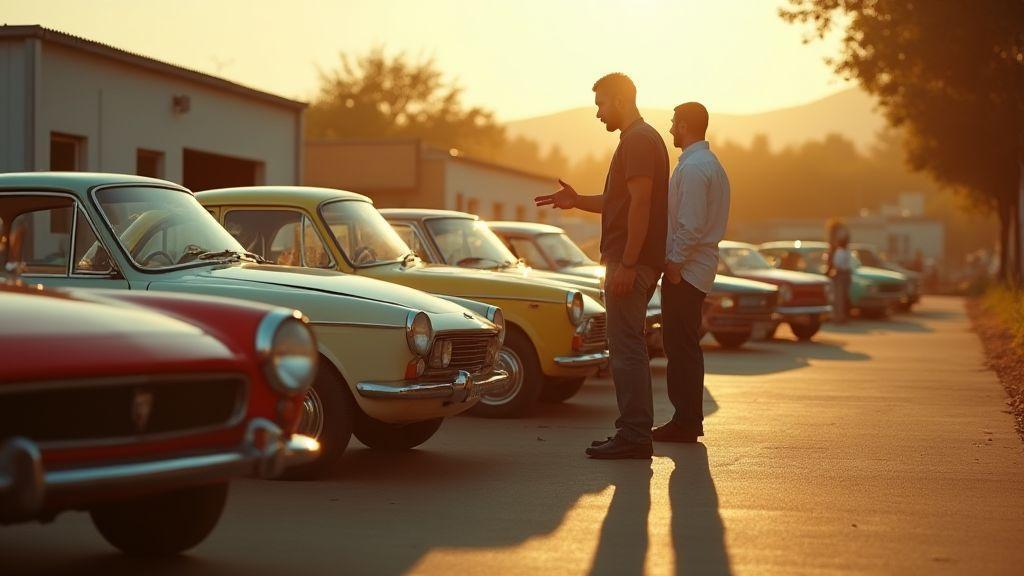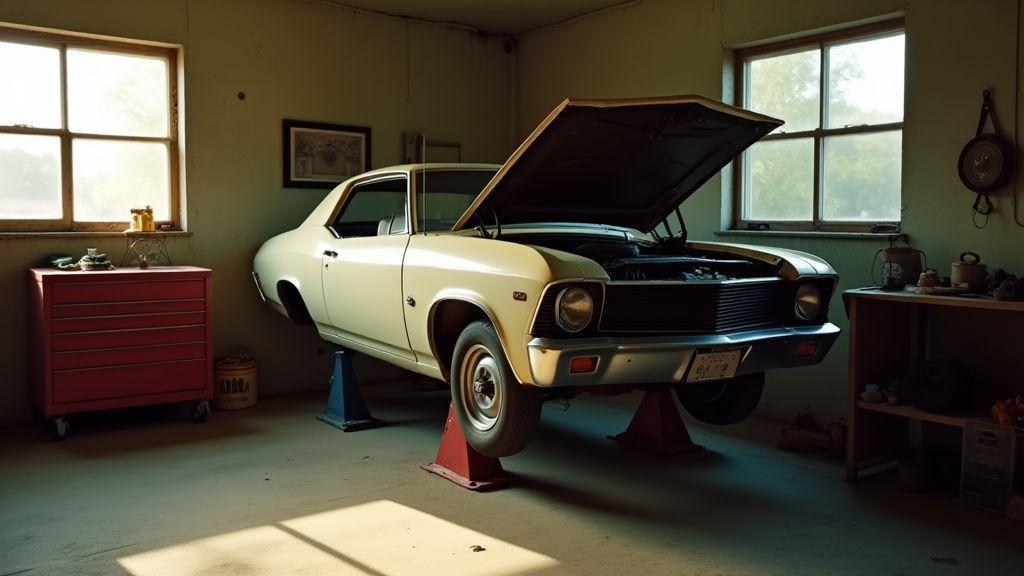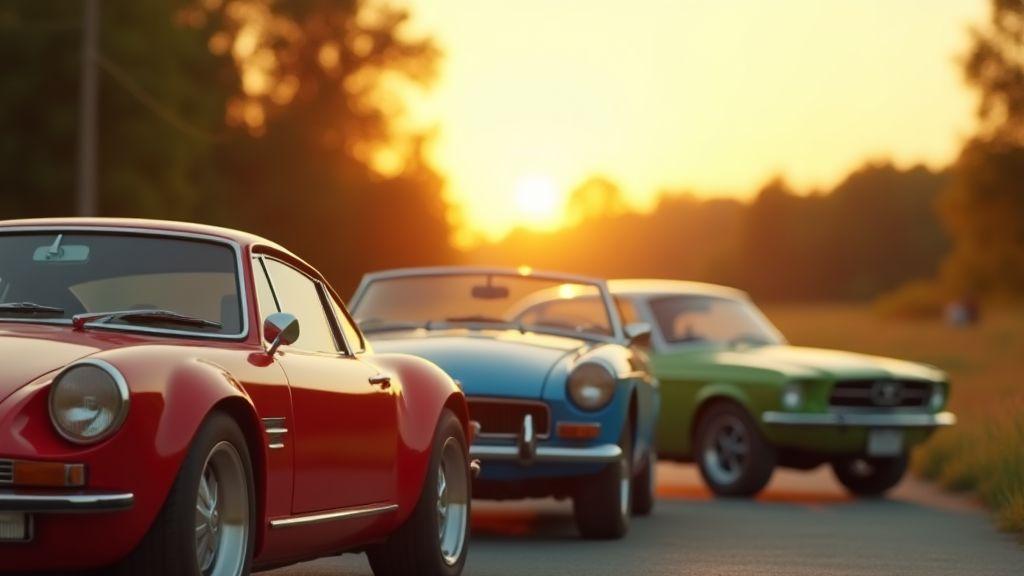Best Classic Cars Under $20,000 to Buy Right Now
You want a classic that turns heads but won’t eat your wallet. You’ll get a simple test drive checklist, learn how to verify VIN, title, and service history, and get a quick buying checklist for safe deals. This guide lists top American, European, and Japanese picks that stay affordable, where to find cars online and at auctions and shows, tips to avoid scams, how to judge reliability, running costs, insurance and registration, an easy plan for small restorations and starter tools, plus a clear value rubric to spot bargains and dodge bad buys.
Key Takeaway
- You can find great classics under twenty thousand.
- Pick models with easy parts and simple engines.
- Budget for rust fixes and regular upkeep.
- Check the VIN and service history before buying.
- Get timeless style and driving fun without huge cost.

How to choose Best Classic Cars Under $20,000 to Buy Right Now
Pick the right classic by first deciding how you’ll use it: weekend cruiser, daily driver, or a project. That choice changes everything—reliability and rust protection matter for a daily; rarity and condition matter for a show car.
Focus on common trouble spots: rust (floors, wheel wells, trunk), engine health, and parts availability. Ask about parts—some models are cheap to fix, others will cost more. Compare repair costs with how much fun the car will give.
Research prices and community support. Use forums, local clubs, and classifieds to see what similar cars sell for. If a deal looks too good, dig deeper. The Best Classic Cars Under $20,000 to Buy Right Now can be great buys, but smart shopping beats buyer’s remorse.
What you should check on a test drive
Start with a cold engine. Listen for knocks, rattles, or long cranks. Let the car warm up—noises that disappear when warm may be minor; persistent bangs are red flags. Watch the tailpipe: blue smoke = oil burning, white = coolant, black = rich fuel.
Drive on varied roads: city, highway, and a bumpy stretch if possible. Check smoothness of gear changes (automatic) and clutch feel (manual). Test the brakes hard enough to judge pull and fade. Note steering play, wheel vibration, or uneven braking. Record issues with your phone or bring a mechanically minded friend. See a Step-by-step used car test drive checklist for more detail.
How to verify VIN, title, and service history
Match the VIN on the dash, door jamb, engine bay, and title. If numbers differ or are scratched, ask why. Check the title for salvage, rebuilt, or lien brands. Run a vehicle history report to view past accidents and odometer checks or Check a vehicle’s VIN and salvage history.
Ask for service records, receipts, and inspection stickers. A stack of dated receipts shows care. Thin records with mismatched mileage and new parts can signal rollbacks. For some classics, matching numbers engines/transmissions matter—confirm that if it affects value (you can Decode a vehicle VIN and recalls). When unsure, have a mechanic or club member inspect documents and the car.
Quick buying checklist for safe purchases
Bring cashier’s check or pre-approved financing; confirm VIN matches title; inspect rust in floors, rockers, and trunk; do a cold start and warm-up check; take a mixed-road test drive to evaluate engine, transmission, brakes, steering, and suspension; review service records; run a vehicle history report; check parts availability and repair costs; negotiate with a repair buffer in mind.
Top affordable classic cars under 20000 and best classic cars for sale under 20000
You can score real classics without blowing your budget. The Best Classic Cars Under $20,000 to Buy Right Now often include Fox‑body Mustangs, early Miatas, Volvo 240s, and BMW E30s—cars with vintage style, simple mechanics, and active communities that keep costs down.
If you crave open-top fun, an NA Miata gives grin-inducing driving for little money. For presence and cheap parts, a Chevy truck or early Mustang fits. For European flair, an E30 or Volvo 240 brings character but expect to address electrical gremlins and rust. Shop with priorities: body condition first, then suspension and brakes. Bring a friend who works on cars or pay for a pre-purchase inspection. Set aside a repair buffer—driveable classics are worth the premium over full barn finds.
American classics you can realistically find
American iron is often the easiest path to a low-cost classic. Fox‑body Mustangs (late ’70s–early ’90s) are common and simple to work on. Third‑gen Camaros, Pontiac Firebirds, and early C‑10 trucks also appear in classifieds and auctions. Parts are cheap and skills widespread; swap meets and Facebook groups help source trim and engine bits. Watch for rust in floors and quarter panels—solid frames and rockers matter most.
European and Japanese picks that stay affordable
Some European cars slip into this price range if you’re patient: BMW E30s, Mercedes W123/W124, and Volvo 240s offer classic looks and driving feel. Repair costs can be higher than American cars, but specialists and parts sources exist.
Japanese classics often provide the best mix of fun and reliability. Early Mazda MX‑5 Miatas are light, nimble, and inexpensive to maintain. Toyota MR2 AW11s and older Celicas also show up at good prices. Expect fewer rust headaches but check for timing-belt service and accident history.
Snapshot of models to watch when shopping
Fox‑body Mustang, Chevy Camaro/Firebird, Chevy C10 truck, BMW E30 3‑series, Mercedes W123/W124, Volvo 240, Mazda MX‑5 NA, Toyota MR2 AW11.

Where to find cheap collector cars under 20000 and used classic cars under 20000
You can find great classics for less than 20000 if you know where to look and what to accept. Start with common models: early ’90s Japanese sports cars, 1970s American V8 cruisers, and compact European cars from the ’80s. Search phrases like “Best Classic Cars Under $20,000 to Buy Right Now” appear on lists and help spot repeat bargains—bookmark the site’s main resource hub (Meridian Pioneer home) and monitor recommended models.
Decide between a ready-to-drive car and a project. A driver costs more upfront but gets you on the road; a project may be cheap to buy but parts and shop time add up. Factor rust, missing trim, and mechanical work into comparisons. Set a repair budget before bidding or buying.
Timing matters: sellers list cars after winter or when they need cash. Holiday weekends and local auctions can reveal deals. Use saved searches and alerts, and talk to local owners at shows—people often point you to cars they haven’t listed yet.
Best online marketplaces and classifieds to search
eBay Motors and Bring a Trailer show finished auction prices; Hemmings and ClassicCars.com list many models; Autotrader has filters for price, distance, and condition. Facebook Marketplace and Craigslist are hit-or-miss but often host private local bargains.
Use filters and saved searches to catch new listings fast. Inspect completed sales to learn market value. Ask sellers for VIN and detailed photos of the engine bay and undercarriage. Treat listings as leads, not guarantees. Before sharing personal details or arranging payment, review the site’s terms of use and privacy policy so you know how listings and communications are handled.
Local auctions, car shows, and club connections you can use
Government, estate, and farm auctions sometimes include older cars sold as-is; read Practical tips for buying at auctions. Local previews let you see cars before bidding—avoid buying unseen. Car shows and club meets are prime places to ask around. Join marque-specific clubs and tell people your budget—owners often share leads or private-sale tips. Swap meets and parts events connect you to community resources and potential bargains.
Tips for safe deals and avoiding scams
Always get the VIN and run a history check, meet in daylight at a public place or the seller’s bank, and if possible bring a mechanic. Avoid wire transfers or unusual payment requests; use cashier’s checks or escrow for large purchases. Ask for a clear title, check for liens, and be wary of sellers who push for quick sales or refuse paperwork. If you need local help or want to report a suspicious listing, use the site’s contact page to reach out for assistance.
How to judge reliability and running costs of reliable classic cars under 20000
Start with service history and receipts—proof of care matters. Look for recent major jobs like timing belt, head gasket, and brake work. If those are missing, budget for them. Talk to owners on forums and read common problem threads for the exact model.
Test the car thoroughly. Drive varied roads, listen for noises, watch temperatures, check for smoke, and try heater and lights. A pre-purchase inspection by a mechanic experienced with classics can spot hidden rust, tired bushings, and cumulative small issues that add up.
Add numbers before you buy: estimate yearly fuel, insurance, registration, and routine service. Include parts and likely small repairs. Compare totals across candidate cars to pick one that’s fun and sustainable.
Typical maintenance items and common failure points
Brakes, suspension, and tires are typical wear items. Brake hoses, pads, and the master cylinder wear out and affect safety. Suspension bushings, shocks, and sway bar links change handling and comfort but are usually cheap to replace.
Engines and cooling systems need attention—old radiators, failing water pumps, and brittle hoses cause overheating. Carburetors and fuel lines can clog, especially with ethanol blends. Electrical issues—bad grounds, brittle wiring, corroded connectors—are common and time-consuming to trace. Know the common parts for your model before buying.
Insurance, registration, and fuel cost tips for buyers
Shop classic-car insurance separately (see Estimate insurance and registration costs). Agreed-value policies often cost less if you drive the car sparingly. Tell insurers estimated annual mileage and whether the car is garaged. Joining a classic-car club can lower premiums and help with historic plates that reduce registration costs.
Fuel and registration rules vary by state. Older cars often use more gas; factor fuel cost for your planned use. Check for lead-seat concerns (valve seat protection) and emissions or safety waiver rules where you live—some jurisdictions offer exemptions.
Simple way to estimate lifetime ownership cost
Add purchase price plus an immediate repair buffer (10–20% of price), then add estimated annual costs (fuel insurance registration routine service small repairs) multiplied by years you expect to keep it. Divide by years or miles to get a per-year or per-mile figure to judge affordability.

Restoration and DIY for classic cars to buy under 20000 and classic cars under twenty thousand now
You can turn a worn classic into a weekend star without spending a fortune. Start by picking a model with good parts support and a simple engine. Cars with carburetors, manual transmissions, and steel bodies are often easier and cheaper to work on. Use the Best Classic Cars Under $20,000 to Buy Right Now list as a filter—it points to machines that balance style, parts availability, and repair simplicity.
Plan work in stages: prioritize driveability (brakes, tires, fluids, tune-up), then address rust and structure, and save paint/full interior for later unless you want a full restoration. Small wins—new shocks, refurbed carb—boost confidence and usability.
Money and time matter. DIY saves money but often takes longer than expected; track hours and receipts. If you choose a popular vintage, community help, parts, and advice will cut costs and speed progress.
Beginner projects with high payoff and low risk
Start with maintenance that improves safety and reliability: oil/filter change, coolant and transmission fluid, brake pads and bleeding, tires, and wheel bearings. These are cheap, teach skills, and make the car safe to drive.
Next, tackle cosmetic and comfort jobs: seat covers, door seals, weatherstripping, polish chrome, and simple electrical fixes (grounds, switches, ignition coil). These are low risk with big visual returns.
Tools, parts sources, and skills you should learn first
Basic toolbox: metric and SAE socket set, torque wrench, jack and stands, screwdrivers, pliers, a wire crimper, and a multimeter. Add a body hammer and sandpaper for minor rust. Buy quality for frequently used tools; borrow or rent specialty tools.
Parts sources: online specialists (RockAuto, eBay), local junkyards, and owner clubs. Learn to read part numbers and match trim codes. Early skills to learn: changing fluids, bleeding brakes, basic wiring, carb/fuel system cleaning, and simple rust assessment. Watch short how-to videos, then practice small tasks.
Basic restoration plan and budget template
Inspect and write a prioritized list: safety, mechanical, body, interior, extras. Allocate roughly 40% to mechanical, 35% to body/rust, 15% to interior, 10% to paint/extras, plus a 10% contingency. For a $10,000 job: ~$4,000 mechanical, $3,500 body, $1,500 interior, $1,000 extras, $1,000 contingency—adjust for the car’s needs and your skills.
Value and investment guide to best classic car bargains under 20000 and top vintage cars under 20000
Aim for classics that give fun now and some value later. Small, popular models with strong parts support—early Miatas, Volvo 240s, and well-kept Fox‑body Mustangs—often sit in this band and straddle daily driveability and collectibility. Search “Best Classic Cars Under $20,000 to Buy Right Now” to find realistic options that won’t wreck your wallet.
Price alone doesn’t make a good buy. Look at production numbers, surviving examples, and current demand. A model with many fans and easy parts usually holds value better than a rare car with no parts or interest. Balance rarity with demand—rare enough to be special, common enough to be repairable.
Expect added costs: servicing, rust repair, and upgrades. If a car looks cheap but needs a floor pan and engine rebuild, that bargain can turn into a money pit. Buy the best example you can afford and leave room in your budget for sensible fixes.
How rarity, condition, and documentation affect value
Rarity raises price only if collectors care and parts-support exist. Condition matters: sound metal, a healthy engine, and a tidy interior save money. Documentation—bills, manuals, clear title, matching numbers—builds buyer confidence and justifies higher prices.
Red flags that show a car is a poor long-term buy
Rust that reaches frames, sills, or suspension mounts is a loud red flag. Salvage/rebuilt titles, mismatched VINs, patchwork repairs, flood damage, odd smells, and persistent electrical gremlins indicate more garage time than road time. If a seller avoids showing rocker panels, trunk seams, or door bottoms, walk away.
Quick rubric to judge investment potential before you buy
Check: body/frame condition, mechanical health, documentation, and market interest. Score each 1–5; only buy if you hit about 14/20 and the work fits your budget.
Conclusion
You can absolutely score a head‑turning classic under $20,000—but only if you shop like a detective and a realist. Start with what you want: a weekend cruiser, a daily driver, or a project. Do the basics: a cold test drive, match the VIN to the title, inspect for rust, and verify the service history. Favor models with easy parts support, simple engines, and active owner communities. Bring a mechanic or pay for a pre‑purchase inspection and budget for immediate fixes plus ongoing maintenance.
Tackle restorations in stages—safety and driveability first, then body and interior. Learn basic skills, build a small toolbox, and lean on forums, clubs, and classifieds for parts and advice. Think like a steward, not a speculator: you want miles of smiles, not months of headaches.
For more model picks, buying tips, and local listing strategies focused on the Best Classic Cars Under $20,000 to Buy Right Now, visit the Meridian Pioneer home.

